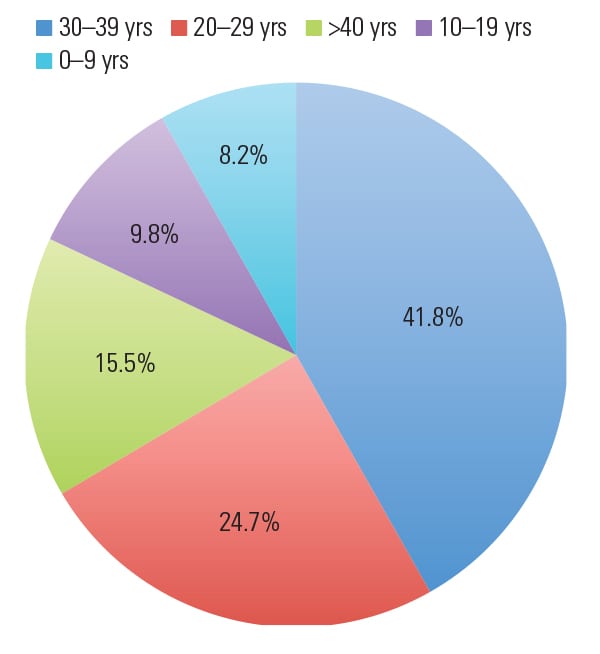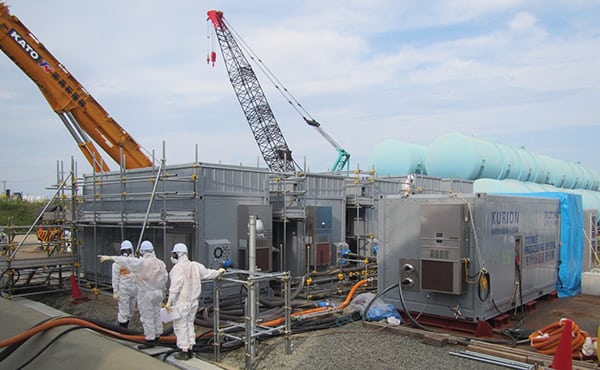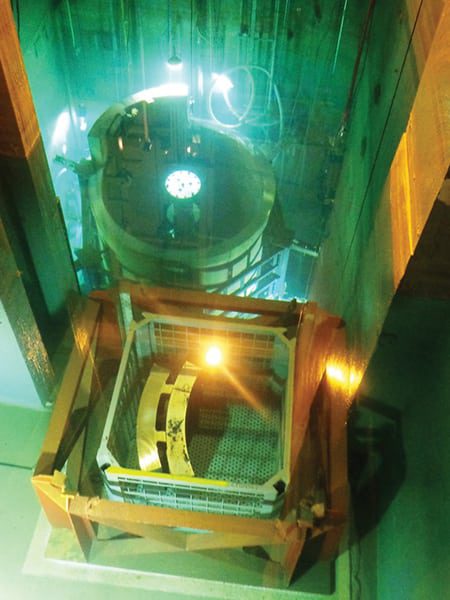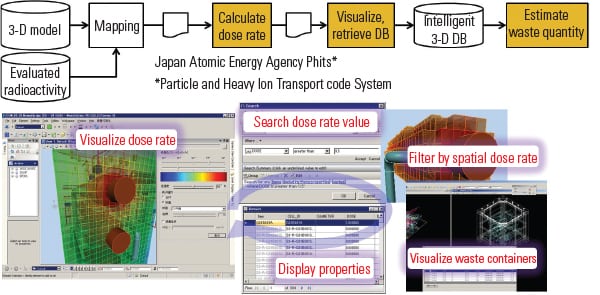Riding Off into the Sunset: Nuclear Decontamination and Decommissioning Update
The International Energy Agency predicts that nearly 200 reactors will be decommissioned during the next 25 years. Industry best practices and new technology can help make the process go more smoothly.
It may not come as a surprise, but the average age of operating reactors in the U.S. is greater than 35 years. There hasn’t been a new nuclear reactor brought online in the U.S. since 1996, but there have been five permanently removed from service in the past three years. Although many plants have had their original 40-year operating licenses extended an additional 20 years, that hasn’t stopped some plants from facing permanent shutdown due to economic and other reasons.
The average age of nuclear power plants in other parts of the world is not significantly less than in the U.S. The majority of the world’s 438 operational reactors—57.3% of them—are at least 30 years old (Figure 1). Germany and Switzerland are planning to phase nuclear power completely out of their energy supplies, and even some politicians in France—a long-time nuclear power stalwart with more than three-quarters of its total electricity production from the source in 2014—are proposing a 50% cap on nuclear power’s contribution to the country’s electricity supply by 2025. The signs are all pointing to significant growth in the global nuclear plant decontamination and decommissioning (D&D) industry.
 |
| 1. Over the hill? This pie chart shows the age distribution of the world’s 438 operational reactors. Source: International Atomic Energy Agency |
Putting a Plant Out to Pasture
There are three Nuclear Regulatory Commission (NRC)–approved strategies for decommissioning nuclear power plants in the U.S. Licensees may choose immediate dismantling (DECON), deferred dismantling (SAFSTOR), or entombment (ENTOMB). In any of the cases, the NRC requires decommissioning to be completed within 60 years. Although regulations in other countries vary, many use decommissioning strategies similar to the NRC’s.
To date, no U.S. plant has ever requested the ENTOMB option of decommissioning. The way the method would work is that a structurally sound material, such as concrete, would be used to permanently encase radioactive material at a site. The owner would continue to monitor and maintain the facility until radioactivity decayed to a level allowing restricted release of the property.
SAFSTOR, on the other hand, has been implemented at several plants. Under this strategy, the plant is maintained and monitored in a condition that allows radioactivity to decay. After radiological levels have decreased, the plant is dismantled and the property is decontaminated to the extent necessary for license termination and release of the property.
Under the DECON method, the process of decontaminating and removing equipment, structures, and other portions of the plant containing radioactive contaminants begins immediately, with the advantage being that the project can be completed more quickly using existing technical systems for various portions of the work.
In some cases, licensees have chosen to pursue a combination of the SAFSTOR and DECON strategies. This hybrid-style method allows immediate dismantlement of some portions of the plant while waiting for radioactivity in other parts of the facility to decay over time. The fact that the U.S. does not have a permanent waste disposal facility for spent nuclear fuel has forced the NRC to implement regulations allowing portions of a facility to be released while a small area remains under license as an “independent spent fuel storage installation.”
Developing a Plan
Patrick O’Sullivan, decommissioning specialist at the International Atomic Energy Agency (IAEA), told POWER that some of the most important items to consider when developing a decommissioning action plan are the facility’s current configuration, physical condition, and the amount and distribution of radiological contamination. The details can be derived from historical records and refined using an appropriate characterization measurement program.
With this information, a material inventory can be developed for the site. Quantities of contaminated material to be removed and levels of contamination are two important decommissioning cost drivers.
“Undertaking a full chemical decontamination of the main coolant circuit following shutdown will reduce significantly the radiation levels in the facility. This, in turn, will facilitate easier access by the workforce for subsequent dismantling work and will reduce the need to use remote technology, which tends to be significantly more expensive and time consuming,” O’Sullivan said.
A general strategy for dismantlement must be developed and integrated with a subsequent waste management strategy. Part of the process includes determining to what extent remotely operated devices will be used. Another aspect to consider is whether components will be removed as single items for final treatment at a specialized facility or if they will be decontaminated and/or segmented onsite.
Incorporating Technology Improvements
Important progress is being made in the field of “broad spectrum” initiatives, according to O’Sullivan. Technology such as 3-D computer-aided design (CAD), pattern recognition, wireless communications, and data sharing via the cloud is being used to improve the D&D process.
O’Sullivan suggested that 3-D imaging, using laser technology (or photos and videos), may soon be translated directly into CAD systems. He said clomid and ovulation artificial intelligence capability could allow machines to recognize the changing site layout from the simulated 3-D model and then perform automated dismantling and material handling.
Hitachi-GE Nuclear Energy is using 3-D plant models in a new decommissioning engineering platform it created for Japanese D&D projects to accurately calculate the amount of material that must be managed as radioactive waste. Specifically, the system assesses the radiation dose for workers, the number of man-hours, and amount of radioactive waste materials generated from the demolition, demolition procedure data, and residual radioactivity.
It uses Hitachi-GE Nuclear Energy’s own CAD system in conjunction with a customization of Bentley Systems’ MicroStation information modeling software and i-model technology for the open exchange of infrastructure information (Figure 2). Bentley’s i-models contain information with engineering precision, allowing not just graphics to be shared, but also building information modeling details that allow such things as the automatic generation of drawings and reports, design analysis, schedule simulation, and facilities management.
The Hitachi-GE platform determines dose rates by mapping radioactive sources on 3-D models of the inside surfaces of equipment and piping and calculating expected gamma radiation. The process involves entering dose rate values on a mesh in MicroStation, color-coding, and providing layers of transparency. The result is a visual representation of dose rates in three-dimensional spaces. But the system doesn’t just color high-dose areas, it also offers filtering capabilities by converting to an i-model and assigning properties that allow search functionality. With that information, areas that require caution for safe entry are easily identifiable.
The system also includes a function for simulating the cutting of equipment and piping, and the packing of waste into containers, using 3-D models. The simulation can calculate the number of waste containers needed, contributing to efficient planning.
Improvements in physical and radiological characterization technology allow a better understanding of the environmental conditions prior to human entry into high-radiation areas. Having a better understanding of the hazards can help avoid “overprotection” of workers. When unnecessary personal protective equipment is prescribed, jobs can take longer, resulting in needless radiation exposure, and it can lead to secondary hazards, such as heat stress.
According to O’Sullivan, practicing dismantling activities in virtual environments is another method that can be used to help minimize radiation exposure. He said distancing workers as far as possible from radiation sources, which is a common practice at operating plants as well, can reduce the radiation dose received, as can using robotics and remote systems whenever practical.
A robotics system developed by Kurion Inc. offers one example of remotely controlled equipment being utilized in the D&D industry. The company successfully deployed an inspection robot to examine reactor containment damage at the Fukushima Daiichi nuclear power plant (NPP). Now it’s developing an advanced robotic arm, called the Fukushima repair manipulator (FRM), to repair reactor primary containment leaks at the plant.
Using cutting-edge robotics technology, the FRM will allow plant workers access to the reactor to open holes, clear debris and obstacles, and plug cracks in the reactor’s vent tubes and torus from the safety of a remote operating station. Kurion’s system will include a robotic arm outfitted with advanced cutting, water-jet, and grouting tools; it also will feature new automatic control sequences to guide these complex tasks. The primary objective of the FRM will be to plug leaks caused by the tsunami that damaged the plant.
In addition to the robotics solutions, Kurion has provided two mobile systems employing ion-specific media to remove radioactive strontium from water stored in tanks at Fukushima (Figure 3). The skid-based systems have removed more than 99.9% of the strontium from the processed water. Although the system is only required in certain D&D circumstances, its modular design makes it flexible and easy to deploy.
 |
| 3. Modular systems allow rapid deployment. Kurion’s skid-based radioactive water treatment system was used to remove strontium from water at the Fukushima Daiichi plant site. Courtesy: Kurion Inc. |
The German Experience
The German government made the decision to phase nuclear power out of the country’s energy mix following the Fukushima disaster. Less than five clomid works by months after that event, the government forced the shutdown of the country’s seven oldest NPPs. It also ended Krümmel NPP’s authorization to operate. Although newer than some other plants that were allowed to remain in operation, Krümmel was offline at the time of the decision as a result of operating trouble that occurred in 2009. It had also been offline for nearly two years following a transformer fire in 2007, so its questionable operating history had placed the plant under heavy scrutiny. The German government also developed a plan for removing the nine remaining commercial reactors from service gradually, through 2022.
Dr. Boris Brendebach is chief expert for decommissioning with Gesellschaft für Anlagen- und Reaktorsicherheit gGmbH, a Cologne-based nonprofit organization that conducts technical-scientific research and provides consultation in the fields of reactor safety, waste management, and radiation and environmental protection—mainly to the German Federal Ministry for the Environment, Nature Conservation, Building and Nuclear Safety. He explained that large decommissioning projects are often divided into phases, working from the “outside to the inside.” Disassembly frequently begins in peripheral structures, such as the turbine building and auxiliary buildings, and moves to components inside the reactor containment.
One advantage of the phased approach is that it allows flexibility. As the project progresses, changes can be implemented more easily when licensing for future phases has not been finalized. Time is allowed for additional information to be gathered so later work packages can be constructed more accurately, using up-to-date details. The phased approach also provides structure so that large, complex technical systems can be methodically dismantled using a step-by-step process.
The Stade Case
As an example, Brendebach offered details on the Stade NPP decommissioning project. The station is located northwest of Hamburg on the Elbe River. It operated from 1972 to 2003 when E.ON Kernkraft GmbH—majority owner and operator of the plant—shut it down for economic reasons. The 630-MW single-unit facility included a Siemens pressurized water reactor (PWR).
The Stade decommissioning utilized a four-phase approach for immediate dismantling. A PWR has both a primary system, which is exposed to radioactive contamination, and a secondary system, which is not exposed to contamination and is very similar to other non-nuclear steam plants.
Once the plant was permanently taken offline, a transition period began. That period lasted roughly a year and a half and allowed comprehensive preparations to be made for the disassembly and removal of plant components and systems, such as planning for the removal of spent fuel rods from the site. However, dismantlement could not begin until government regulators granted the permit for decommissioning.
Once authorized, phase one of the decommissioning process included the removal of items that ultimately created more room for subsequent work. Reactor containment structures may look large from the outside, but space is tight on the inside. At Stade, the control rod assemblies were taken out during this phase to free up space inside the reactor chamber. The flood tanks—previously used to feed the primary loop during startup and shutdown—were removed, as were the pressurized emergency cooling tanks located inside the containment. Some secondary system components, such as turbine and generator components, steam and feedwater systems, and the emergency diesel generator, were also removed.
Removing the steam generators and primary coolant piping and pumps was the main focus of the second phase of decommissioning, which took more than two and a half years. Phase three involved dismantlement of some of the most contaminated components, such as the reactor pressure vessel and the fuel racks used in the spent fuel pool. These components cannot be decontaminated because they become radioactive themselves after years of neutron exposure while the plant is in operation. Concrete shielding and slabs were also removed during this phase.
The final phase of nuclear D&D at Stade will involve the removal of all remaining systems and components. Cranes, ventilation systems, and water treatment components will be dismantled during this stage. The remaining buildings will be cleaned and decontaminated so that the radiation control area can be eliminated. At that point, the site will be released from regulatory control and conventional dismantling will continue. In the end, the area will be restored to green fields and released for unrestricted use. The project is scheduled to finish by 2018.
Interim storage of low- and medium-level radioactive waste from the site has been accomplished through the use of a temporary storage facility built adjacent to the Stade plant. The facility was constructed with the expectation that the German federal government will provide a permanent waste disposal facility sometime within the expected 40-year service life of the structure. (For another case study, see the sidebar.)
| Ignalina: Decommissioning Chernobyl’s Big Sister
The Ignalina Nuclear Power Plant (INPP) is located in eastern Lithuania near Visaginas—a town of more than 20,000 people founded in the mid-1970s for workers constructing INPP and for the purpose of supporting the plant. INPP operated two RBMK-1500 water-cooled graphite-moderated channel-type power reactors, which is the same reactor type that was installed at the Chernobyl Nuclear Power Plant, although that plant had four 1,000-MW reactors.Following the Chernobyl accident in 1986, plans for additional units at INPP were scrapped, even though Unit 3 was estimated to be about 60% complete. The two finished units were allowed to operate, albeit at a reduced thermal power output. During the process of preparing for accession to the European Union (EU) and North Atlantic Treaty Organization (NATO), and at the urging of the international community, the Lithuanian government agreed to retire INPP. Unit 1 was permanently shut down in December 2004, and Unit 2 was removed from service in December 2009. As part of the agreement, the EU is funding a portion of INPP’s decommissioning. POWER received an update on INPP’s decommissioning plan and progress from SE INPP Director General Darius Janulevicius. Read details and see several photos of the project in the supplement to this story, “Ignalina: Decommissioning Chernobyl’s Big Sister.” |
Cutting and Packaging
A lot of planning and consideration must be given to radioactive waste disposal when decommissioning and dismantling a nuclear plant. Material that can’t be decontaminated must be disposed of at a radioactive waste disposal facility, so minimizing the size and volume of material, that in many cases is irregularly shaped, can be tricky. Many of the components are very large, such as the reactor vessel (RV) and reactor vessel head (RVH), and usually can’t be removed from the facility intact.
Westinghouse Electric Co. LLC has been engaged in a project near Madrid, Spain, at the José Cabrera Nuclear Power Station (also known as the Zorita plant). The unit was an early vintage 160-MW PWR. It operated from 1968 to 2006, when it was closed by ministerial order.
Although Unión Fenosa operated the plant, ownership was transferred to Empresa Nacional de Residuos Radiactivos S.A. (ENRESA) for decommissioning. ENRESA contracted with Westinghouse to dismantle and segment the RV internals in 2010. Following successful completion of the project, Westinghouse was selected to dismantle and segment the RV and RVH in 2013.
To begin the RV and RVH project, Westinghouse spent the first six months conducting engineering studies, completing design work, and manufacturing equipment needed for the job. Detailed 3-D modeling was used to design tools and determine the optimal strategy for cutting and disposing of waste. Radiological conditions and packaging constraints were considered along with many other factors.
After thorough evaluation, mechanical cutting was the method chosen for segmentation. This is similar to the strategy used at the Zion plant in Illinois, which was covered in the July 2014 issue of POWER (see “Evolved Strategy Accelerates Zion Nuclear Plant Decommissioning”), but with more portable tools. Westinghouse had used most of the tools needed for mechanical cutting at José Cabrera for segmentation of the RV internals, but it qualified new tools developed specifically for the RVH and RV segmentation project—that is, tested and proved the tools functioned as designed—at its test facility in Västerås, Sweden.
The RVH—a 19-ton piece made of thick carbon steel with stainless cladding—was the first component to be segmented. Westinghouse used a band saw placed on the pool floor for the majority of the task but also used disc cutting techniques for some cuts. The RVH was cut into 26 pieces and packaged into three roughly cube-shaped containers, each measuring about 5.5 feet per side. The entire cutting was done in the water-filled spent fuel pool to minimize dose exposure for personnel.
The 100-ton RV was cut and packaged in a similar manner, using the same equipment, with minor modifications. Cut pieces, weighing about 1 ton per piece on average, were packaged in wastebaskets (Figure 4) and removed from the pool as work progressed. Cutting and packaging was optimized to save time and space in containers, making the process as cost efficient as possible. To ensure all component transport and segmentation work could be performed underwater, Westinghouse had cut an opening between the reactor cavity and spent fuel pool, and reinforced and resealed the spent fuel pool during the RV internals segmentation project.
 |
| 4. Cut and packaged. The reactor vessel is segmented under water, and pieces are placed in a waste container for removal. Courtesy: Westinghouse Electric Co. |
Many important lessons were learned during these projects, which Westinghouse plans to utilize during future decommissioning jobs. The group said preparatory work is essential and there is no replacement for past experience. Utilizing previously proven tools and methods helped accelerate the process and reduce cost. Contingency strategies are frequently needed to accommodate for systems that may already have been removed from the plant, but planning for these can minimize surprises. All in all, the team found that mechanical cutting worked very well for dismantling the José Cabrera RV internals, RV, and RVH, and the company believes it can be successfully used on future projects, regardless of the reactor type.
Decommissioning Costs: A Moving Target
The cost of decommissioning a nuclear power plant is a huge liability. Even before a reactor begins operation in the U.S., the NRC requires the licensee to establish a funding mechanism to ensure that there will be sufficient money available to decommission the facility when the time comes. The status of decommissioning funds must be reported to the NRC biennially, including estimates of the minimum amount needed for decommissioning, which can be projected using formulas found in NRC regulations.
Many factors can influence the cost of decommissioning a reactor, such as type, size, location, and proximity to disposal facilities, but the NRC estimates that most projects in the U.S. can be completed for $300 million to $400 million. Approximations vary greatly, however. In a letter to the California Public Utilities Commission in March, Southern California Edison—majority owner of the San Onofre Nuclear Generating Station (SONGS)—estimated that the cost to decommission SONGS Units 2 and 3 would be $4.4 billion.
An IAEA report on decommissioning costs for WWER-440 nuclear power plants—35 of which were built mostly in the 1970s and 1980s in former Soviet bloc nations—shows that cost estimates can vary by more than sixfold, depending on which member state is making the projection. In the report, Germany predicted the cost to decommission a WWER-440 unit would be $1.37 billion, but Finland calculated that it would only be $220 million.
Increasing Confidence in Estimates
One company believes it has found a method to reduce the uncertainty. Enkom is a cost consultancy company based in the UK. It says it works with clients to develop cost and data structures that effectively and efficiently capture and report project cost and time data. According to the company, its skill in the nuclear sector is drawn from personnel who have extensive experience providing professional services on projects involving construction, operation, and decommissioning of facilities.
In 2011, Enkom was appointed by Magnox Ltd.—a site-licensed company responsible for management of 10 nuclear power plants across the UK—to improve the accuracy of estimates, increase confidence in the baseline, and establish reliable cost data for “lead and learn” (a system designed to enable better decision making). With a focus on increasing confidence, one of the most significant challenges was to improve the accuracy and reliability of the cost-estimation process.
The UK estimating protocol at the time did not typically account for the flexibility and fluidity of ongoing scope definition or changing decommissioning practices. Enkom developed a technique using data and analysis to increase the initial accuracy of cost estimation by retaining an appropriate level of detail within the estimate while maintaining the ability to refine and improve the data through a modeling approach.
“Our approach involved the establishment of a common cost structure along with a library of project case studies and cost norms for projects, ultimately providing a significantly more accurate cost estimation,” Martyn Jenkins, managing director of Enkom, told POWER.
The strategy involved establishing ratios comparing management and supervision to project delivery, deriving project cost norms for benchmarking future projects and creating a “benchmark dashboard report” with focused information for managers. Enkom’s experience with Magnox over the past few years has led to the establishment of a common cost structure and cost norms for projects. Using standardized engineering and technical solutions has helped Magnox begin to overcome cost estimation challenges, thereby providing more robust decommissioning plans.
As a result of its work in cost estimating and cost management on nuclear projects, Enkom was recently engaged to provide subject matter expertise on a UK-wide commission to carry out benchmarking of civil nuclear schemes to underpin independent reviews of D&D programs.
—Aaron Larson is a POWER associate editor.
